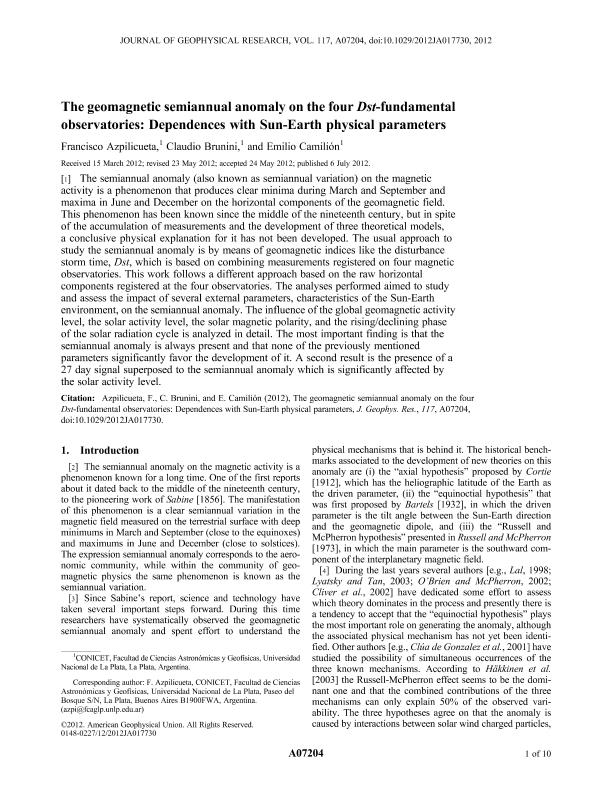Mostrar el registro sencillo del ítem
dc.contributor.author
Azpilicueta, Francisco Javier

dc.contributor.author
Brunini, Claudio Antonio

dc.contributor.author
Camilion, Emilio

dc.date.available
2020-01-16T20:41:05Z
dc.date.issued
2012-07
dc.identifier.citation
Azpilicueta, Francisco Javier; Brunini, Claudio Antonio; Camilion, Emilio; The geomagnetic semiannual anomaly on the four Dst-fundamental observatories: Dependences with Sun-Earth physical parameters; American Geophysical Union; Journal of Geophysical Research; 117; A7; 7-2012; 1-10
dc.identifier.issn
0148-0227
dc.identifier.uri
http://hdl.handle.net/11336/94996
dc.description.abstract
The semiannual anomaly (also known as semiannual variation) on the magnetic activity is a phenomenon that produces clear minima during March and September and maxima in June and December on the horizontal components of the geomagnetic field. This phenomenon has been known since the middle of the nineteenth century, but in spite of the accumulation of measurements and the development of three theoretical models, a conclusive physical explanation for it has not been developed. The usual approach to study the semiannual anomaly is by means of geomagnetic indices like the disturbance storm time, Dst, which is based on combining measurements registered on four magnetic observatories. This work follows a different approach based on the raw horizontal components registered at the four observatories. The analyses performed aimed to study and assess the impact of several external parameters, characteristics of the Sun-Earth environment, on the semiannual anomaly. The influence of the global geomagnetic activity level, the solar activity level, the solar magnetic polarity, and the rising/declining phase of the solar radiation cycle is analyzed in detail. The most important finding is that the semiannual anomaly is always present and that none of the previously mentioned parameters significantly favor the development of it. A second result is the presence of a 27 day signal superposed to the semiannual anomaly which is significantly affected by the solar activity level.
dc.format
application/pdf
dc.language.iso
eng
dc.publisher
American Geophysical Union

dc.rights
info:eu-repo/semantics/openAccess
dc.rights.uri
https://creativecommons.org/licenses/by-nc-sa/2.5/ar/
dc.subject
Ionosphere
dc.subject
semiannual anomaly
dc.subject
Dst index
dc.subject
geomagnetic activity
dc.subject
geomagnetic semiannual anomaly
dc.subject
geomagnetic semiannual variation
dc.subject.classification
Otras Ciencias de la Tierra y relacionadas con el Medio Ambiente

dc.subject.classification
Ciencias de la Tierra y relacionadas con el Medio Ambiente

dc.subject.classification
CIENCIAS NATURALES Y EXACTAS

dc.title
The geomagnetic semiannual anomaly on the four Dst-fundamental observatories: Dependences with Sun-Earth physical parameters
dc.type
info:eu-repo/semantics/article
dc.type
info:ar-repo/semantics/artículo
dc.type
info:eu-repo/semantics/publishedVersion
dc.date.updated
2019-09-27T14:32:44Z
dc.journal.volume
117
dc.journal.number
A7
dc.journal.pagination
1-10
dc.journal.pais
Estados Unidos

dc.description.fil
Fil: Azpilicueta, Francisco Javier. Universidad Nacional de La Plata. Facultad de Ciencias Astronómicas y Geofísicas; Argentina. Consejo Nacional de Investigaciones Científicas y Técnicas; Argentina
dc.description.fil
Fil: Brunini, Claudio Antonio. Universidad Nacional de La Plata. Facultad de Ciencias Astronómicas y Geofísicas; Argentina. Consejo Nacional de Investigaciones Científicas y Técnicas; Argentina
dc.description.fil
Fil: Camilion, Emilio. Universidad Nacional de La Plata. Facultad de Ciencias Astronómicas y Geofísicas; Argentina. Consejo Nacional de Investigaciones Científicas y Técnicas; Argentina
dc.journal.title
Journal of Geophysical Research

dc.relation.alternativeid
info:eu-repo/semantics/altIdentifier/url/https://agupubs.onlinelibrary.wiley.com/doi/full/10.1029/2012JA017730
dc.relation.alternativeid
info:eu-repo/semantics/altIdentifier/doi/http://dx.doi.org/10.1029/2012JA017730
Archivos asociados
